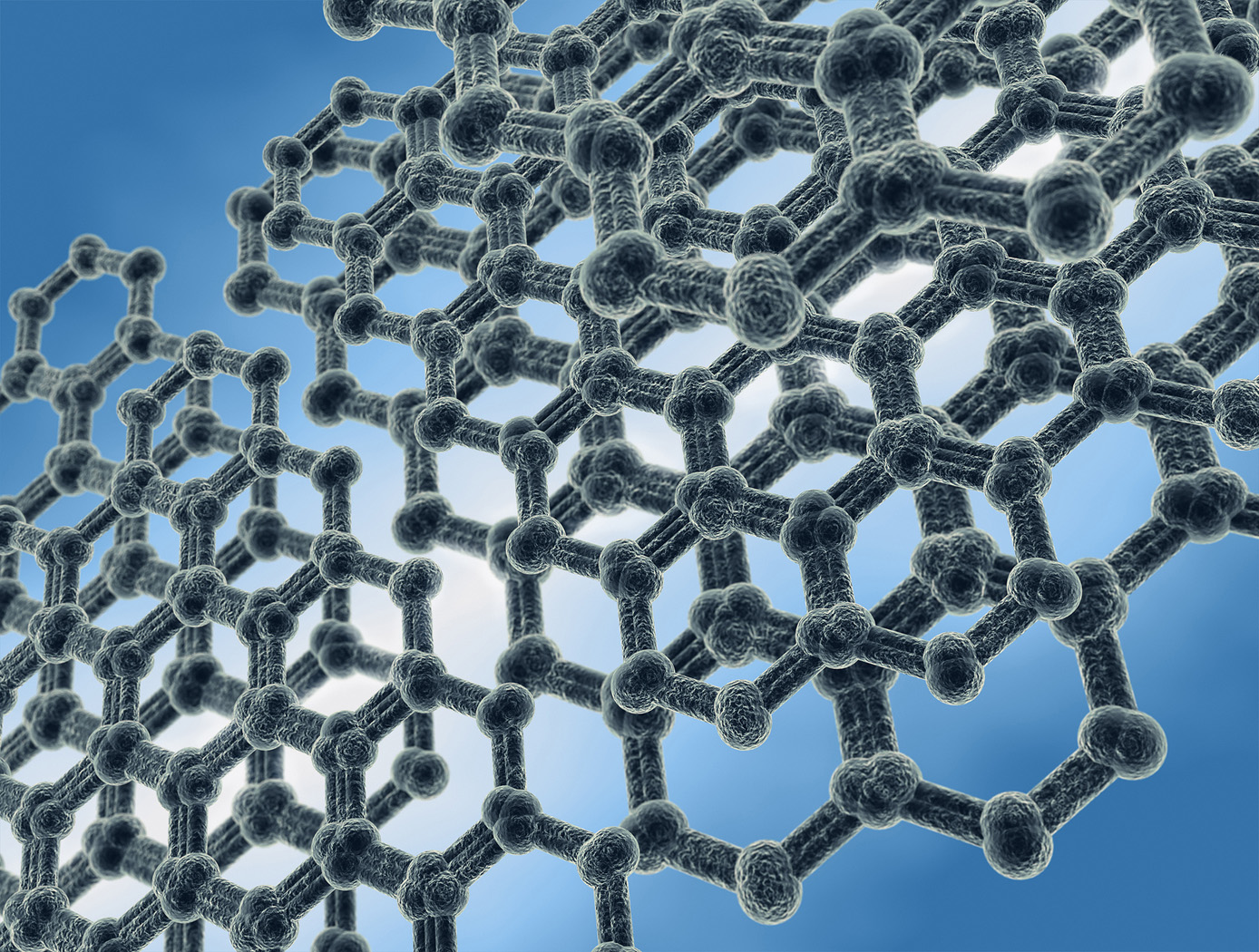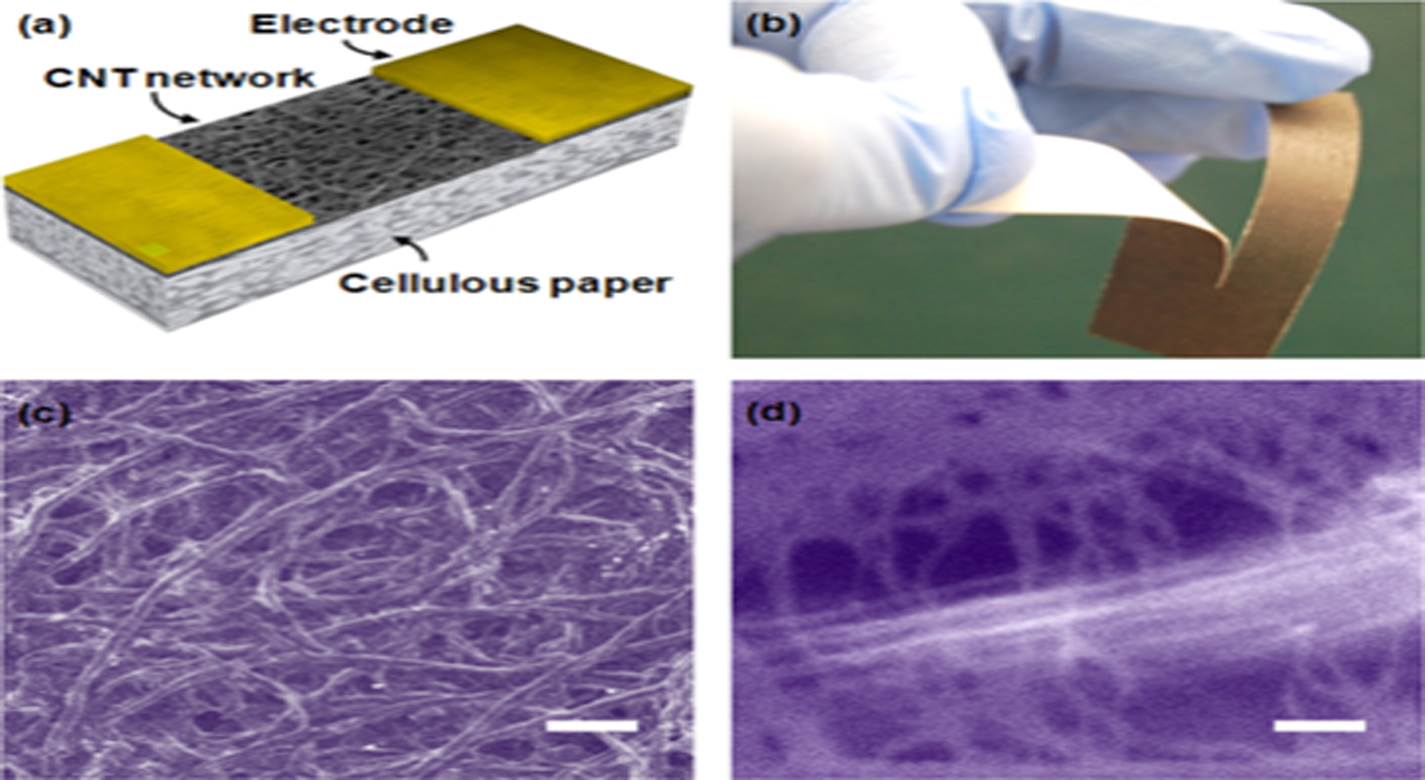Electrical Response Using Nanotubes on a Fibrous Substrate
sensors
Electrical Response Using Nanotubes on a Fibrous Substrate (TOP2-172)
Gas and vapor sensors on paper
Overview
This NASA technology is a a unique resistor-type gas/vapor sensor on cellulose paper employing carboxylic acid functionalized, single-walled carbon nanotubes as the sensing material. Electronic devices built on cellulose paper substrates can be cheaper than equivalent class of solid-state devices while providing excellent performance. Furthermore, the paper-based devices can be used for flexible, foldable, biodegradable, disposable applications, such as biosensors and intelligent packaging. Single-walled carbon nanotubes (SWCNTs) are used to construct the sensor on paper. Gas sensors are typically classified according to transduction methods and each class has its own strengths and weaknesses. These sensors are characterized by their simple structure, low fabrication cost, and simple read-out circuitry.
The Technology
A resistor-type sensor was fabricated which has a network of cross-linked SWCNTs with purity over 99%. An ordinary cellulose paper used for filtration was employed as the substrate. The filter paper exhibits medium porosity with a flow rate of 60 mL/min and particle retention of 5-10m. The roughness and porosity of the papers are attractive because they increase the contact area with the ambient air and promote the adhesion to carbon nanotubes. The SWCNTs were functionalized with carboxylic acid (COOH) to render them hydrophilic, thus increasing the adhesion with the substrate. The functionalized SWCNTs were dispersed in dimethylformamide solution. The film composed of networks of cross-linked CNTs was formed using drop-cast coating followed by evaporation of the solvent. Adhesive copper foil tape was used for contact electrodes. Our sensors outperformed the oxide nanowire-based humidity sensors in terms of sensitivity and response/recovery times.


Benefits
- Simple structure, low fabrication cost and simple read-out circuitry
- No heating or vacuum treatment needed
- Simple solution processing
- Cheaper than equivalent class of solid-state devices
- Foldable, flexible, biodegradable and disposable
- Green Technology
- Robust in cryo-temperatures
- Wide range of applications
Applications
- Biosensor technology
- Industrial mining
- Intelligence / Security
- Biomedical
Similar Results

Gas Sensors Based on Coated and Doped Carbon Nanotubes
A typical sensor device includes a set of interdigitated microelectrodes fabricated by photolithography on silicon wafer or an electrically insulating substrate. In preparation for fabricating the SWCNT portion of such a sensor, a batch of treated (coated or doped) SWCNTs is dispersed in a solvent. The resulting suspension of SWCNTs is drop-deposited or injected onto the area containing the interdigitated electrodes. As the solvent evaporates, the SWCNTs form a mesh that connects the electrodes. The density of the SWCNTs in the mesh can be changed by varying the concentration of SWCNTs in the suspension and/or the amount of suspension dropped on the electrode area. To enable acquisition of measurements for comparison and to gain orthogonality in the sensor array, undoped SWCNTs can be similarly formed on another, identical set of interdigitated electrodes. Coating materials tested so far include chlorosulfonated polyethylene. Dopants that have been tested include Pd, Pt, Au, Cu and Rh nanoparticle clusters. To date, the sensor has been tested for NO2, NH3, CH4, Cl2, HCl, toluene, benzene, acetone, formaldehyde and nitrotoulene.

Solid State Carbon Dioxide (CO2) Sensor
The technology is a solid state, Carbon Dioxide (CO2) sensor configured for sensitive detection of CO2 having a concentration within the range of about 100 Parts per Million (ppm) and 10,000 ppm in both dry conditions and high humidity conditions (e.g., > 80% relative humidity). The solid state CO2 sensor achieves detection of high concentrations of CO2 without saturation and in both dynamic flow mode and static diffusion mode conditions. The composite sensing material comprises Oxidized Multi-Walled Carbon Nanotubes (O-MWCNT) and a metal oxide, for example O-MWCNT and iron oxide (Fe2O3) nanoparticles. The composite sensing material has an inherent resistance and corresponding conductivity that is chemically modulated as the level of CO2 increases. The CO2 gas molecules absorbed into the carbon nanotube composites cause charge-transfer and changes in the conductive pathway such that the conductivity of the composite sensing material is changed. This change in conductivity provides a sensor response for the CO2 detection. The solid state CO2 sensor is well suited for automated manufacturing using robotics and software controlled operations. The solid state CO2 sensor does not utilize consumable components or materials and does not require calibration as often as conventional CO2 sensors. Since the technology can be easily integrated into existing programmable electronic systems or hardware systems, the calibration of the CO2 sensor can be automated.

Inexpensive Microsensor Fabrication Process
Because chemical sensors are used in many aspects of space missions, NASA researchers are continually developing ever smaller and more robust sensors that can be manufactured inexpensively and in high quantities; e.g., in batches. Glenn has developed a way to inexpensively fabricate microsensors using a sacrificial template approach. A nanostructure, such as a carbon nanotube, serves as a template, which can then be coated with a high-temperature oxide material. The carbon nanotube can be burned off, or sacrificed, leaving only the metal oxide. The resulting structure provides the unique morphology and properties of the carbon nanotube, which are advantageous for sensing, along with the material durability and high-temperature sensing capabilities of the metal oxide. This technique increases the surface area available for sensing because both the interior and exterior of the resulting microsensor can be used for gas detection, significantly increasing performance.
The fabrication of these microsensors includes three major steps: (1) synthesis of the porous metal or metal oxide nanostructures using a sacrificial template, (2) deposition of the electrodes onto alumina substrates, and (3) alignment of the nanostructures between the electrodes. The invention has been demonstrated for methane detection at room temperature (using tin oxide, with carbon nanotubes as the sacrificial template). The microsensor offers low power consumption (no heating required), compact size, extremely low cost, and simple batch-fabrication.

Systems and methods employing nanomaterial sensors for detecting conditions impacting a Volatile Organic Compounds (VOCs) profile in breath
The technology involves a sophisticated system designed to detect conditions through the analysis of exhaled breath, utilizing an array of nanomaterial sensors fabricated upon a standard printed circuit board with interdigitated electrodes. These sensors are configured to interact with a sample gas that contains various Volatile Organic Compounds (VOCs) associated with a variety of biological conditions. Each sensor consists of nanomaterials, such as carbon nanotubes, composite nanotubes, nanoparticle-doped nanotubes, or polymer-coated nanotubes, all disposed on an electrically conductive structure. These sensors are highly sensitive to specific VOCs at a broad spectrum of concentrations, and each sensor generates a unique measurable electrical signal on interaction with VOCs in the breath that reflects the presence and concentration of specific components in the sample gas. The previously nanosensor diagnosis technology has been further developed to identify 64 specific formulations of nanomaterials that exhibit unique and varying sensitivities to VOCs, which enables unique response signatures to be developed for a wide range of VOCs. A single device may be developed using these principles to detect a variety of health conditions and diseases.

Composite Dielectric Inks for Humidity Sensing
The NASA technology is based on a perovskite ceramic developed at MSFC, reduced lanthanum barium titanate (rLBT). rLBT is comprised of reduced barium titanate (BaTiO3) doped with lanthanum (La) and co-doped with potassium hydroxide (KOH). rLBT was developed while exploring the suitability of sintered perovskites to produce screen-printed ultracapacitors; the prototypes unexpectedly demonstrated an extreme sensitivity to moisture, prompting exploration of the material for use as a vapor-sensitive dielectric ink.
To eliminate inconvenient high temperature firing necessary to produce capacitors, the inventors developed rLBT-loaded polymer composites capable of curing under low heat (110 degrees C) for epoxy or under ultraviolet (UV) light for UV-sensitive resin. At suitable ceramic particle loading concentrations, thin ink layers (30 micrometers) demonstrate RH sensitivity, instantaneously detecting breath vapor (RH change from 30% to 93%) with a recovery time of only 1s. Prototypes demonstrated near log-linear response curves over three orders of magnitude of capacitance with minimal drift (see Figures 1 and 2).
NASA’s low temperature dielectric ink for humidity sensing is at technology readiness level (TRL) 4 (component performance has been validated in a lab setting) and the related patent is now available to license. Please note that NASA does not manufacture products itself for commercial sale.



